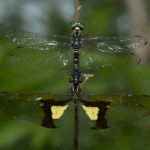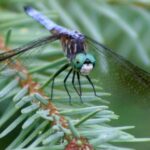Dragonfly Wings
Have you ever wondered how dragonfly wings get their patterns and why they appear glassy? Let’s find out.
HOW DO DRAGONFLY WINGS GET THEIR PATTERNS?
The patterns of dragonfly wings are like fingerprints – no two are exactly the same! The wing pattern is caused by a complex network of crisscrossing secondary veins that create up to thousands of small, yet simple, shapes. The endless variation to the shape and position of these secondary veins, creates unique patterns on each wing.
Researchers have postulated that this infinite pattern making ability may result from signaling centers in the space between the primary veins that send out inhibitory signals preventing the growth of secondary veins in certain areas. These inhibitory zones appear random and they repel one another. Thus, the secondary veins are forced to grow around these inhibitory zones creating the dragonfly’s complex wing geometry.

WHY DO DRAGONFLY WINGS LOOK GLASSY?
The vein structure of a dragonfly’s wing is contained within a very thin, shiny film of chitin. Chitin is a starch that makes up the exoskeletons of most insects. In its pure form, chitin is translucent, pliable, resilient, and very tough. The extreme thinness of dragonfly wings makes them appear glassy and reflective.
How dragonflies use ultrafast wing movements to flip over in flight
Dragonflies use a combination of visual cues and precise control of their wing pitch to perform aerial acrobatics.
The four-winged insects can rapidly right themselves from an upside-down position but until now, researchers weren’t sure how they performed the feat. Jane Wang, who studies the physics of living organisms at Cornell University in New York, first noticed the intriguing behaviour almost eight years ago. To her surprise, when she dropped a dragonfly headfirst, the insect flipped itself faster than her eyes could follow.
So Wang and her colleagues designed a series of experiments to find out exactly how the insects managed it. First, they painted white dots on the wings and bodies of seven dragonflies. Then, they released the insects upside down and recorded their movement with a high-speed video camera. They slowed down the footage to get a better look at the precise wing angles and used a computer algorithm to create a three-dimensional model of the dragonflies in motion.

The digital simulation revealed what Wang’s eyes couldn’t see: the dragonflies were pitching their right and left wings at different angles to flip over in just 200 milliseconds.
“When [dragonflies] normally beat their wings, they are constantly changing their pitch,” says Wang. “Now, on top of that, they have to create a difference between the left and the right wings – just by a small amount.”
Some dragonflies rolled to the right, others went left. But in all cases, the insects used a similar asymmetrical wing angle to flip in mid-air.
The experiment revealed the physical mechanism of the dragonflies’ lightning-fast rotation, but didn’t answer how they sensed that they were upside down to begin with. Drawing on previous research, Wang says she suspected they might be using visual input from their large, multi-lens eyes, or from light-sensitive organs called ocelli on top of their head.
The team then blocked the dragonflies’ eyes and ocelli with an opaque black paint, and again released the insects upside down. This time, they couldn’t right themselves. “Sometimes they didn’t flap their wings at all,” says Wang.
The researchers concluded that visual signals must help the insects orient themselves in space, which then prompts a specific wing movement. Wang suspects dragonflies aren’t the only ones employing this two-part technique.

“I think almost all flying insects have such an ability, because it’s a necessity,” she says. “Dragonflies are one of the most ancient insects. If they have already evolved it, I suspect the modern ones have a similar ability.”
Dragonfly wings: tried and tested over millennia!
Dragonfly wings are thin and light and have a corrugated-like structure. There are lots of tiny cells between numerous veins and cross veins, which together form a stiff, yet relatively flexible structure which is able to bear alternating wing loads during the flight. Some veins are stiffer than others, particularly those at or near the leading edge, but also some of the cross veins. This gives the wing a unique combination of stiffness and flexibility. Dragonflies are remarkable fliers, and there have been many detailed investigations of their aerodynamic abilities; I have just dipped my toes into what is a voluminous literature.

A large dragonfly can reach a top speed of somewhere between 36 and 54 km/h (22 to 34 mph), and they are also highly maneuverable. Their cruising speed is probably closer to 12 or so km/hr, beating their wings about about 30 times per second. They are remarkably agile aerial predators, able to adjust their flight, and change direction, at any speed (including hovering).
The basic wing pattern of dragonflies has remained remarkably constant over geological time, which suggests that once this particular model had evolved, it was retained (or remained a conserved feature) for hundreds of millions of years. The Protodonata, the ancestors of modern dragonflies (Odonata), were flying in the Carboniferous, so they have had plenty of time to perfect their aerial abilities! They were also a lot larger than modern day dragonflies, so the wings would appear to work well on a larger scale!

All dragonfly wings have two noticeable features: a nodus and a stigma (see below). The pterostigma, to give it its full name, is a hollow blood-filled structure on the leading edge of the wing. As well as being a pigmented spot – which may play a role in communication – it also has a significant effect on the aerodynamics of the wing. According to a study by R. Åke Norberg Norberg (at the University of Göteborg, in Sweden), because it is a slightly heavier part of the wing, it has a marked effect on the gliding ability of the dragonfly, enabling it to glide at speeds, 10–25% faster, in one species.






